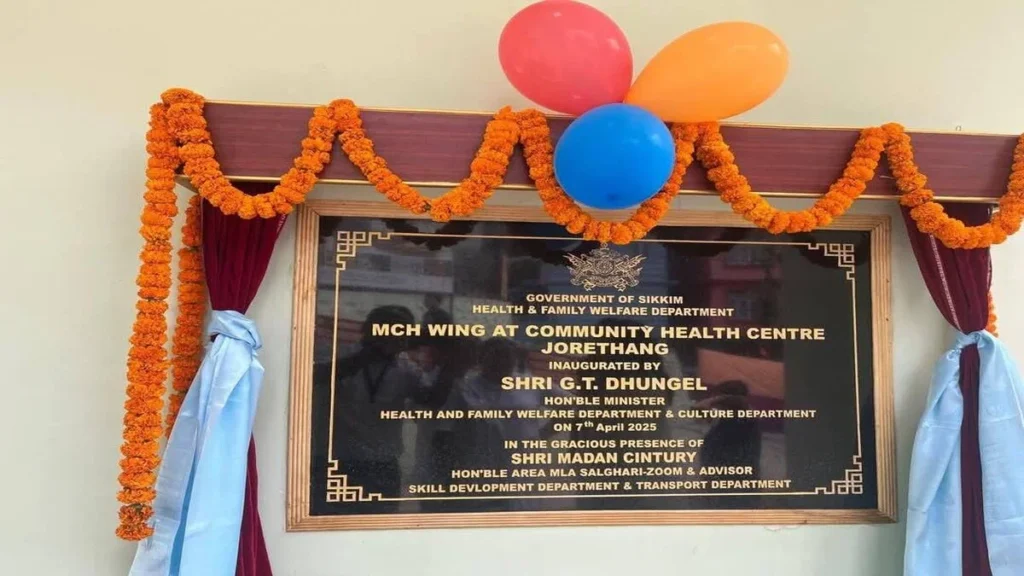Jorethang, Sikkim
Sikkim’s Health Minister, G.T. Dhungel, inaugurated a state-of-the-art Maternal and Child Health Wing at Jorethang’s Community Health Centre today. This marks a significant upgrade in healthcare services for South Sikkim’s residents. The inauguration, timed with World Health Day celebrations, represents the state government’s continued commitment to improving rural healthcare infrastructure.
The new facility, constructed at a cost of ₹3.2 crore, features:
- A 30-bed dedicated ward for maternal and child health services
- 24/7 emergency obstetric care unit
- Specialized neonatal care corner
- Integrated AYUSH consultation rooms
Key officials at the ceremony included NHM Mission Director Anusha Lama, District Medical Officer Dr. S.N. Adhikari, and local MLA Madan Cintury. Over 200 community members, including ASHA workers and local panchayat representatives, participated in the event.

Addressing Critical Healthcare Gaps
Until now, pregnant women in Jorethang and surrounding villages faced significant challenges:
- 78% had to travel 40+ km to Namchi District Hospital for deliveries
- Only 62% attended the recommended four antenatal checkups
- The infant mortality rate in the region stood at 28 per 1,000 live births
The new wing directly tackles these issues by providing:
- Comprehensive antenatal and postnatal care
- Emergency delivery services
- Vaccination and child nutrition programs
- Health education sessions for mothers
“This facility will be a game-changer for hundreds of families in South Sikkim,” said Minister Dhungel during his inaugural address. “We’re ensuring quality healthcare reaches every mother and child, regardless of where they live.”
Meeting National Standards
The Jorethang CHC fully complies with Indian Public Health Standards (IPHS) for community health centres. Key upgrades include:
Staffing Improvements:
- The addition of two specialist obstetricians
- Three staff nurses trained in emergency obstetric care
- Dedicated paediatrician
Infrastructure Enhancements:
- Modern labour room with fetal monitoring equipment
- Newborn stabilization unit
- 24-hour pharmacy and diagnostic services
Dr Priya Sharma, the centre’s newly appointed obstetrician, explained, “We can now handle high-risk pregnancies that previously required referral. This saves crucial time in emergencies.”
Community Impact and Response
Residents have welcomed the development with enthusiasm.
Maya Rai, a 24-year-old expectant mother from nearby Sombaria village, shared: “My first pregnancy required monthly trips to Namchi. Now I can walk to my checkups in 15 minutes.”
ASHA worker Deepika Chettri noted: “Earlier, we struggled to convince women about institutional deliveries. This facility removes the distance barrier.”
Challenges and Future Plans
While celebrating the achievement, officials acknowledge ongoing challenges:
- Staff Retention: Attracting specialists to rural postings remains difficult
- Maintenance: Sustaining advanced medical equipment requires steady funding
- Awareness: Some communities still prefer traditional birth attendants
The Health Department has initiated solutions:
- Offering special incentives for doctors in rural postings
- Training local nurses in advanced procedures
- Community awareness campaigns through ASHA networks
The government plans to replicate this model in three more CHCs across Sikkim by 2026.
A Model for Mountain Healthcare
Public health experts highlight the Jorethang project’s significance for hill states facing similar challenges.
Dr Ramesh Kumar, regional advisor for maternal health, commented: “Sikkim is demonstrating how to adapt national healthcare standards to mountainous terrain. Their focus on local needs while meeting IPHS requirements sets an important precedent.”
The state’s health indicators already show positive trends:
- Maternal Mortality Ratio down from 118 (2018) to 97 (2024)
- Institutional deliveries increased from 76% to 89% in five years
- Full immunization coverage at 92%, above the national average
Conclusion
The Jorethang Maternal and Child Health Wing represents more than just a new building – it’s a lifeline for South Sikkim’s families. By bringing specialist care closer to remote communities, Sikkim continues to lead the way in innovative healthcare solutions for mountainous regions.
Health Minister Dhungel concluded: “This is not our final destination, but an important milestone in our journey toward health equity. Every mother and child in Sikkim deserves the best care, and we won’t stop until that’s reality.”
Key Facts:
- Project cost: ₹3.2 crore
- Service area: 25 villages, approx. 50,000 population
- Staff strength: 12 medical professionals
- Services: Full obstetric care, pediatric services, immunization










